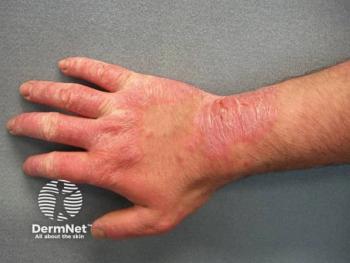
- Dermatology Times, June 2025 (Vol. 46. No. 06)
- Volume 46
- Issue 06
Diagnosing and Managing GPP: Top Insights From the Experts
Key Takeaways
- GPP presents with sudden sterile pustules and systemic inflammation, complicating diagnosis due to its heterogeneous nature and similarity to other conditions.
- Timely diagnosis is challenging due to GPP's rarity and requires thorough patient history, medication review, and full-body examination.
Aaron Farberg, MD, led a panel exploring the challenges of diagnosing and treating generalized pustular psoriasis and the promise of targeted therapies.
Aaron Farberg, MD, a double board-certified dermatologist and chief medical officer at Bare Dermatology in Dallas, Texas, led a panel of colleagues in conversation for a Dermatology Times Clinical Case Collective custom video series,
The Heterogeneous Face of GPP
Generalized pustular psoriasis (GPP) presents as sudden, widespread eruptions of sterile pustules, often accompanied by significant systemic inflammation. It is a rare and potentially life-threatening autoinflammatory disease that accounts for less than 1% of all psoriasis cases. While the name implies generalized pustules, the clinical presentation is heterogeneous, making initial recognition and diagnosis difficult. The panel emphasized that although the classic picture involves widespread erythema studded with sterile pustules, patients may present at different stages of the disease process.
Bhutani elaborated on this variability and said, “Depending on when they present in the course, oftentimes those pustules have already dried out. You might just see these collarettes of scale.... It’s not always your textbook ill patient coming in with a fever and pustules all over their body.” Farberg added that the pustules sometimes look smaller and more yellow on the surface. Beyond the cutaneous findings, systemic involvement is a hallmark. Nguyen highlighted these features, including fever, chills, joint pain, arthralgias, and even vital sign disturbances involving the liver, heart, or kidneys.
“Sometimes these patients have a history of psoriasis, sometimes they don’t, and so that lends [itself to] the challenge of making the right diagnosis,” Nguyen added. Farberg agreed and noted that the pain is what catches patients’ attention and brings them into the clinic.
Navigating Diagnostic Challenges and Triggers
The rarity of GPP directly affects timely diagnosis. As Bhutani pointed out, due to its infrequency, “many people may never have heard of this. In dermatology, we’re lucky to get the education like this and learn from it, but for people in primary care or emergency [departments], oftentimes where these patients are presenting...they’ve never heard of this before, and that obviously leads to delays in diagnosis.”
A primary diagnostic challenge lies in differentiating GPP from other similar-looking conditions, particularly acute generalized exanthematous pustulosis, or pustular drug eruption. Patients often have a history of psoriasis, arthralgias, or arthritis, which can help differentiate. A meticulous history, including medication review and a thorough full-body skin examination, is paramount.
“You have to have all these patients in a gown and check every square inch of their body,” Farberg stressed. Although GPP remains largely a clinical diagnosis, the panel acknowledged the potential use of skin biopsy; however, the first step is clinical impression based on how the patient is looking and feeling. With the potential risk of severe systemic complications, including multiorgan failure and death, early and accurate diagnosis is critical.
Understanding and identifying potential triggers for GPP flares is essential for patient management and counseling. Although triggers can include infections, stress, pregnancy, and certain medications, the panel placed significant emphasis on one particular culprit.
“One of the things that can flare or cause a rebound of the GPP is withdrawal from the corticosteroids. And we live in, unfortunately, a high–systemic corticosteroid world,” Bunick said. He mentioned spesolimab (Spevigo; Boehringer Ingelheim), the first FDA-approved, advanced IL-36 receptor inhibitor that does not harm in the same way systemic steroids do. Infections can also serve as potent triggers.
The Profound Emotional Burden of GPP on Patients
The impact of GPP extends beyond its visible manifestations. The panelists stressed the profound burden this disease places on patients’ lives, especially as pain and itch are significant drivers of morbidity, even in the healing phase. The unpredictable nature of flares and the lack of clear triggers also contribute to psychological distress, which may be the hardest part of disease management, according to Bhutani.
“Patients feel like they’re walking around with a ticking time bomb. They just don’t know when it’s going to go off or if they’re going to do something that’s going to set off a flare.... Even between flare-ups, these patients have a terrible quality of life because they’re just waiting for their disease to flare up,” she explained. Study data have supported this, showing that the quality of life in patients with GPP is much worse than in those with plaque psoriasis. The negative impacts are present in all aspects of daily life, including physical activity, socialization, and work.
This burden also affects the entire family, who may become fearful every time a GPP flare appears, as severe flares can be life-threatening and often require hospitalization. Associated comorbidities, including diabetes, cardiovascular risk factors, arthritis, anxiety, and depression further compound the challenge. Acknowledging and addressing this psychosocial toll is integral to holistic patient care.
Clinical Preparedness and Management Strategies
Given the severity and diagnostic complexities, preparedness is key. Bunick emphasized the need for established clinical workflows for every office and every provider, especially for patients at potential high risk. This will help ease the anxiety of seeing a rare condition and not necessarily knowing what to do.
“The more you see something, the more comfortable you are being able to rapidly diagnose [and] treat. Although GPP is very rare, are you and your office staff prepared to mobilize quickly to help that patient? What are the next steps?” he said. This includes processes for rapid assessment, appropriate workup, navigating insurance hurdles for advanced therapies such as spesolimab, and initiating treatment promptly.
A carefully tailored approach with multidisciplinary collaboration between clinicians can advance treatment success. Additionally, patient education, reassurance, and support are equally vital. Nguyen highlighted the importance of validating the patient’s experience.
“When I first explain the diagnosis of GPP to a patient, I take the time to emphasize to the patient that they are in the right place. We are going to be with them every step of the way, and we understand the impact that the condition has on multiple facets of the patient,” he said. “I try to emphasize how important it is for us to support them through their journey. I want them to feel comfortable talking to me about their quality-of-life impact so that we can get them the right tools or resources to be able to cope with their condition.” Resources such as stress management tools, mental health support, and patient advocacy groups such as the National Psoriasis Foundation can be very valuable.
Future Horizons for Personalized GPP Care in Dermatology
The landscape of GPP management is evolving, offering hope for improved patient outcomes through enhanced awareness, diagnostics, and targeted interventions. The advent of therapies specifically designed to target the underlying pathophysiology, such as spesolimab, marks a significant shift. The drug, supported by Effisayil 1 (NCT03782792) and Effisayil 2 (NCT04399837) trial results, is now approved for both treating acute flares and preventing future ones.
“Prior to spesolimab, it was harder for patients to cope, and there’s a longer period they had to suffer. But the advantage of having an advanced systemic therapy is they don’t have to cope too long. They don’t have to suffer too long if we can get them the medicine fast,” Bunick said.
This therapeutic progress, coupled with potential future advances in diagnostics such as genetic testing for IL36RN mutations, underscores the urgent need for greater clinical preparedness and established treatment guidelines. Bridging the gap between therapeutic innovation and practical implementation through continued education, streamlined diagnostic classification, and efficient office protocols will be crucial. This allows clinicians not only to identify GPP sooner but also to leverage personalized treatments more effectively and mitigate associated comorbidities, moving away from potentially harmful approaches such as broad systemic corticosteroids and toward rapid, targeted relief for patients experiencing this rare condition.
Articles in this issue
5 months ago
Dermatology Times June 2025 Print Recap6 months ago
Nail Trends That Challenge Clinical Diagnosis6 months ago
Inside IL-17 Inhibitors Advancing Psoriasis CareNewsletter
Like what you’re reading? Subscribe to Dermatology Times for weekly updates on therapies, innovations, and real-world practice tips.



















